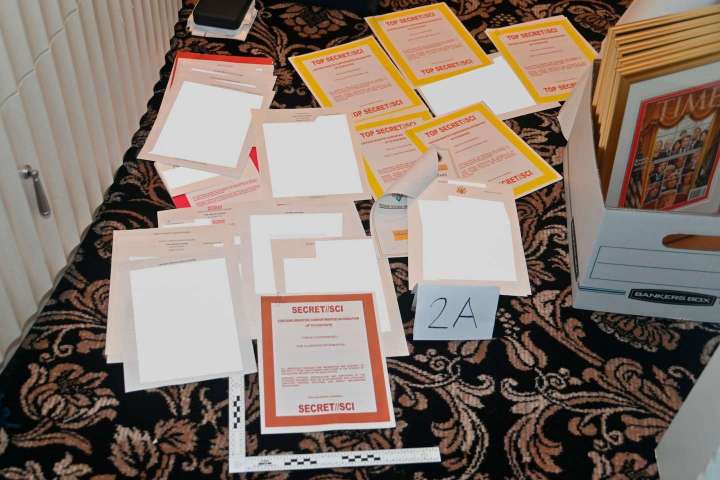In their latest court filing related to the seizure of material from Donald Trump’s Mar-a-Lago estate, the former president’s attorneys made a remarkable assertion Wednesday about the scale of what was recovered.
Did the FBI really seize 200,000 pages of documents at Mar-a-Lago?

Setting aside the claim about the transcript (which has been made available, including to Washington Post reporters), the claim is striking. The understood scale of what was removed from Trump’s office and a storage room at the facility — generally that 11,000 figure — may be off by a factor of 18.
But: Is it? Is it conceivable that there were some 200,000 pages of material seized, bolstering the Trump team’s argument that the whole process should be slowed down significantly?
Not really, no.
As it happens, the government released an updated list this week of what it took when it searched the property. It recovered 33 identified groups of material, including 26 boxes or containers from the storage room, and one box and six collections of documents from Trump’s office. The contents break down as follows:
|
Loose documents |
Government documents/photos |
||
|
Classified documents |
|||
|
News articles/clippings |
|||
|
Box/container |
Government documents/photos |
||
|
Classified documents |
|||
|
News articles/clippings |
|||
|
Empty folder |
|||
|
Storage room |
Box/container |
Government documents/photos |
|
|
Classified documents |
|||
|
News articles/clippings |
|||
|
Clothing/gifts |
|||
|
Empty folders |
|||
It’s important to note that there is no indication that the seized material includes any sort of digital device. We lack a good vocabulary to describe the extent of digital material, often using the term “pages” to refer to things like emails, which aren’t generally presented as printed documents. But here that’s not an issue. There’s no indication that the 200,000-page total is bolstered by, say, a thumb drive containing a number of files.
So it’s just paper. And paper has one important constraint: volume.
I happen to have a ream of paper by my desk. It measures 8.5 inches by 11 inches (the size of a standard sheet) by 2 inches deep. That’s 500 sheets, fresh off the production line. We don’t know how big the boxes were that were recovered, admittedly, but photos taken during Trump’s administration and of his departure from the White House on Jan. 20, 2017, show that material was often transported in banker’s boxes. In the famous photo of documents arrayed on the floor of Mar-a-Lago, you can see a banker’s box containing framed photos of Time magazine covers.
A banker’s box is about 10 inches by 12 inches by 15 inches. In other words, it can hold about 10 reams of paper. Meaning that if all of the material seized from Mar-a-Lago were compressed into ream-sized bundles — not typically possible with paper that’s been printed upon or otherwise used — it would take 40 bankers’ boxes to hold 200,000 pages. (Ten reams times 500 sheets is 5,000 sheets per box.) And the FBI removed only 27 boxes.
If we assume that those 27 boxes were stuffed with 5,000 sheets each, that accounts for about 135,000 pages of documents. Meaning that those other six loose groupings of documents would have to account for the other 65,000 pages. Since those groupings included 1,436 identified documents, that would necessitate that each of those 1,436 identified documents was an average of 45 pages in length. Which, given the photo of classified documents released by the Justice Department, seems unlikely.
But those boxes included things besides simple sheets of paper. There were 33 books and 19 items marked as “clothing/gifts.” There were those mysterious empty folders, 88 of them. If we assume that the books each took the space of half a ream of paper and that the gifts each used the space of a full ream, the stuffed-to-the-gills boxes now hold only 117,000 pages or so, meaning the average size of the individually grouped documents soars to 57 pages.
The contents of the boxes, incidentally, would have to average about 10 pages per document, if we assume that the pages of the books are not counted to the total. (Of course, given how all of this has played out, they may very well be included.) We know that much of what was seized, though, wasn’t 10 pages long. As journalist Marcy Wheeler points out, more than 1,500 of the documents included in the boxes found in the storage room are identified as news clippings. I’ve never seen a news clipping that runs to 10 pages; usually, they’re one or two. Take those out and the average length of the other documents necessarily stretches to 12 pages.
Bear in mind that we know what some of those documents look like: We have that photo. None of those documents (found in the box recovered from the office) appear to be 12 pages in length. Did Trump select only the unusually short documents to keep in his office? Or is all of this based on trying to bolster a 200,000 pages claim that’s impossible to defend?
That seems to be the most likely answer. Trump’s attorneys want to throw roadblocks in the path of the Justice Department and are using this claim of the scale of what was recovered to demand more time for their review. Not only do they admit that the total is secondhand, but they also have a reason to want the number to be as high as possible.
So the idea that the FBI walked out of Mar-a-Lago lugging hundreds of thousands of documents seems to be pretty clearly inaccurate.






